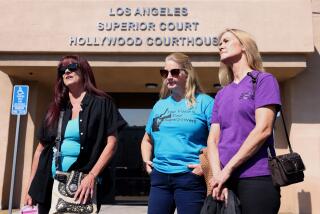State to Move Sherman Oaks Parole Office : Corrections: Facility, which was located across the street from recreation center, will be returned to North Hollywood.
SHERMAN OAKS — Bowing to pressure from an influential homeowners group and politicians, state officials announced Wednesday they will move a parole office they opened less than one month ago.
Opponents had argued that its location at 5121 Van Nuys Blvd.--directly across the street from the Van Nuys/Sherman Oaks Recreation Center--violates the state Corrections Department’s own guidelines for placing parole offices away from parks and schools.
The announced move was lauded by the Sherman Oaks Homeowners Assn. but bitterly criticized by residents of Van Nuys and North Hollywood, who complained that parole offices in their less-glamorous neighborhoods never generated the same swift political response.
“Is it right to introduce the fox to the henhouse in some other area?” Van Nuys activist Candace Campbell asked politicians during a news conference at the Van Nuys/Sherman Oaks Recreation Center.
Other angry residents carried signs that said, “Stop Dumping in Van Nuys” and “Van Nuys Residents Also Vote.”
In fact, officials said, the parole office will not return to an old location in Van Nuys, near Hazeltine Street and Victory Boulevard, but to one in North Hollywood near the corner of Laurel Canyon Boulevard and Vanowen Street.
The move back to 6736 Laurel Canyon Blvd. will be complete within 90 days and only administrative work and training will remain at the Sherman Oaks location, pledged Corrections Director James Gomez. Parolees’ visits there--an estimated 35 to 40 a day--will be phased out over the next several weeks.
The Van Nuys and North Hollywood facilities had become overcrowded and were closed in favor of a single, larger office in Sherman Oaks meant to monitor about 4,100 convicted felons who served time in state prison and now live in the Valley.
Corrections officials settled on the Sherman Oaks building--despite its location across from a park and senior citizens center--because it was the only lease they could secure after a two-year search, Gomez said.
He said the former Watterson College Building was among 29 sites considered, and that the landlords of the 28 other properties withdrew from negotiations.
But the choice began generating controversy soon after it opened on April 25 when residents started phoning police and politicians to express fears that seasoned criminals would loiter around the office and prey upon the children and senior citizens using the park across the street.
*
About 15% to 20% of California’s paroled felons are rearrested, prosecuted and returned to state prisons, and law enforcement authorities say there is a significant overlap between neighborhoods plagued by high crime rates and those where parolees congregate.
Nonetheless, the parole offices that operated in Van Nuys and North Hollywood for five and 10 years, respectively, did so virtually without notice by residents and left no record of complaints, said Regional Parole Administrator Jerry DiMaggio.
Moreover, the new office in Sherman Oaks generated no known crimes or other problems during its brief, 3 1/2-week life, DiMaggio and other officials said Wednesday.
“There’s really no foundation for the hysteria,” DiMaggio said.
He and Gomez said the move back to North Hollywood will be complicated because a new lease will have to be renegotiated and the staffs of two overcrowded offices will be crammed into one. Their plans also call for moving the administrative staff from an earthquake-damaged building downtown to the Sherman Oaks facility, leased to the department for about $2 million over the next five years.
Those who led the effort to have the parole office moved-- homeowners association President Richard Close, City Councilman Zev Yaroslavsky, state Sen. David Roberti (D-Van Nuys) and state Assemblywoman Barbara Friedman (D-North Hollywood)--lavished praise on each other Wednesday for a response they described as unprecedented in terms of speed.
“In my 19 years of activism, I’ve never seen such fast work by government officials,” Close said at the news conference.
The outcry also prompted Friedman and Roberti to introduce legislation requiring the Corrections Department to be more specific when it notifies elected officials about plans for a new parole office. A notice about the Sherman Oaks office sent out last year, for example, stated its address but did not mention the potential use.
Gomez promised Wednesday the department will change its notification form. “They are right,” he said, “it is inadequate.”
*
But in exchange for franker notices and the agreement to move from Sherman Oaks, the state’s policy of placing parole offices at least a quarter of a mile from schools and parks will remain a guideline only and not be codified into law, Friedman said. Originally, the bill would have made the quarter-mile buffer mandatory, she acknowledged.
One North Hollywood resident who opposes the parole office’s return there charged Wednesday that the Laurel Canyon site also violates the state’s quarter-mile guidelines. Marlene Aragon said it is two-tenths of a mile from the North Hollywood Park and Recreation Center.
“I just wish they’d consider the whole Valley,” Aragon said. “They’ve been looking out for Sherman Oaks’ interests. . . . What we need is some balance.”
More to Read
Sign up for Essential California
The most important California stories and recommendations in your inbox every morning.
You may occasionally receive promotional content from the Los Angeles Times.










